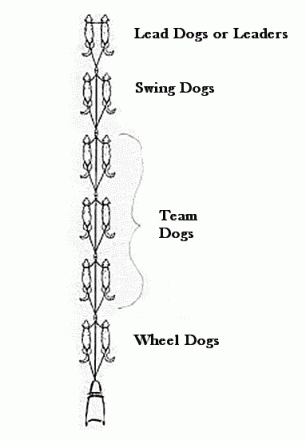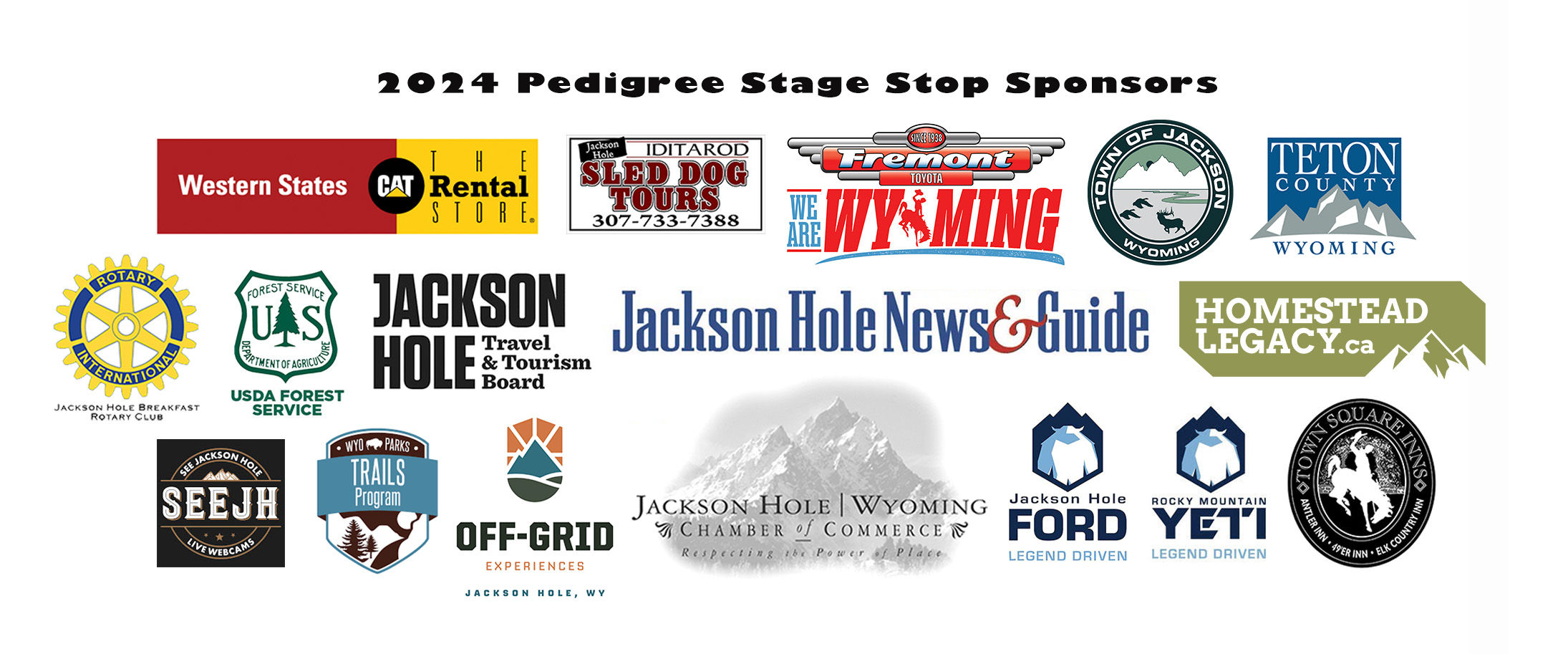Commentary by Jerry Bath
It’s almost time for the 2019 Pedigree Stage Stop Race! While we’re all getting ready, it might be useful to review some terminology before the race.
SLED DOG POSITIONS
You’ve probably seen a photo or video of sled dogs pulling a musher across the snow. Or maybe you’ve seen them at a race or tour company, or perhaps a neighborhood friend has a kennel. But did you know each sled-dog pair has a specific role in navigating the trails and terrain on every run?
The dogs are positioned in pairs on either side of a gangline, or mainline, that attaches to their harnesses and to the sled. Pedigree Stage Stop Race rules state that a musher may start a race with a maximum of 14 on the truck and no more than 10 dogs on the line. Most Stage Stop mushers start the race with the maximum 10 dogs per day.

Lead dogs: Some say the most critical part of the team, lead dogs set the pace and keep the other dogs on the trail. They are the dogs that respond to the musher’s commands of “gee” (right turn) and “haw” (left turn). Lead dogs must be alert and intelligent so they can find and follow the trail when it is covered over with snow. They also keep the other dogs in the team moving by keeping the gangline tight. Some mushers might use only one lead dog but it is more common to see two.
Swing (or point) dogs: Positioned directly behind the lead dogs, the swing dogs help steer the team around corners. As lead dogs make a turn, the swing dogs pull the team in an arc that keeps the other dogs on the trail and brings the sled and musher safely around a corner.
Team dogs: The team’s core. They pull the sled and maintain speed or pace. There can be several pairs of team dogs, depending on the size of the team.
Wheel dogs: These are the two dogs closest to the sled. Not necessarily the largest of the dogs but sometimes they are the most agile, often needing to cross over the main line while going around corners and then return to their original position.
It is not uncommon, though a bit time-consuming, for mushers to switch dogs’ positions during a race. Some dogs make better leaders in certain weather conditions but not others. Sometimes, after a run, a musher may wish to give a lead dog a break or day off. A big plus about being in a stage race with a pool!
TERMINOLOGY
Gang line (or main line): The center line attached to the sled that all dogs are hooked or fastened to.
Tug line: A tug line attaches the dog to the main line.
Neck line: The line that attaches the dog to the main line, or to another dog.
Snow hook: An anchor of sorts with fins that attaches to mainline on the sled behind the dogs to anchor the team in the snow when stopped.
Snub line: A line attached to the main line on the sled behind the dogs that is used for tying the sled off securely.
The lines are usually made of some kind or variation of poly-pro, preferably something that does not soak up moisture and freeze. Some have a light cable inside for added strength and safety.
Booties: You might see some of the dogs wearing colorful booties. The booties protect the dogs’ feet from the abrasive snow or ice. Booties are generally made of sturdy materials such as polar fleece, nylon, or canvas. Two pieces are sewn together to form a pocket that slips over the dog’s foot and are held in place by Velcro.
FUELING THE ATHLETES
The average sled dog burns 10,000 calories a day on the trail, so dogs must be regularly fed. Food is the fuel that keeps the dogs’ engines going. Before the race, some mushers feed a warm soup with a meaty base. Each musher comes up with his or her own special formula. After the race mushers usually use an electrolyte snack to bounce the dogs back as quickly as possible. Later in the day they feed the dogs the main meal that may include a high-protein, high-fat quality kibble, various meats and supplements, and ALWAYS plenty of fresh water.
